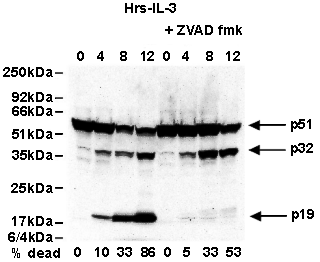Product Details
| Clone: | 11B4 |
| |
| Host: | Rat |
| |
| Isotype: | IgG2a |
| |
| Immunogen: | Recombinant human caspase-2 p19 fragment. |
| |
| UniProt ID: | P42575 |
| |
| Species reactivity: | Human, Mouse, Rat
Dog, Monkey
|
| |
| Specificity: | Recognizes an epitope in the p19 subunit of human, mouse, rat, monkey and dog caspase-2. Detects bands of ~51kDa (procaspase-2), ~32kDa and ~18kDa (cleavage products) by Western blot. |
| |
| Applications: | IP, WB
|
| |
| Recommended Dilutions/Conditions: | Western Blot (2µg/ml)
Suggested dilutions/conditions may not be available for all applications.
Optimal conditions must be determined individually for each application. |
| |
| Application Notes: | Detects bands of ~51kDa (procaspase-2), ~32kDa and ~18kDa (cleavage products) by Western blot.
For FC, ICC and IHC (FS) use MAb to Caspase-2 (10C6) (Prod. No. ALX-804-355). |
| |
| Purity Detail: | Protein G-affinity purified. |
| |
| Formulation: | Liquid. In PBS containing 0.02% sodium azide. |
| |
| Handling: | Avoid freeze/thaw cycles. |
| |
| Shipping: | Blue Ice |
| |
| Short Term Storage: | +4°C |
| |
| Long Term Storage: | -20°C |
| |
| Regulatory Status: | RUO - Research Use Only |
| |

Figures: Western blot analysis of cell lysates from human and mouse cell lines with clone 11B4. Clone 11B4 demonstrates its ability to recognize an approximately 51 kDa protein that corresponds to endogenous pro-caspase-2. Hsp-70 was used as an equal loading control, and -/- caspase-2 cells were used as a negative control.

Figure: Detection of procaspase-2 (p51), an intermediate cleavage product of caspase-2 (p32) and activated caspase-2 (p19) in FDC-P1 cells (mouse IL-3 dependent promyelocytic line) during growth factor withdrawal induced apoptosis. Activation of caspase-2 is inhibited in the presence of the caspase inhibitor Z-VAD-FMK (
ALX-260-020 or
ALX-260-138 (Ready-to-Use))."
Please mouse over
Product Literature References
Caspase-2 and p75 neurotrophin receptor (p75NTR) are involved in the regulation of SREBP and lipid genes in hepatocyte cells: D.D. Pham, et al.; Cell Death Dis.
10, 537 (2019),
Abstract;
Full Text
ER Stress Drives Lipogenesis and Steatohepatitis via Caspase-2 Activation of S1P: J.Y. Kim, et al.; Cell
175, 133 (2018),
Abstract;
Taxane-mediated radiosensitization derives from chromosomal missegregation on tripolar mitotic spindles orchestrated by AURKA and TPX2: M. Orth, et al.; Oncogene
37, 52 (2018),
Abstract;
Full Text
Cleavage of Ku80 by caspase-2 promotes non-homologous end joining-mediated DNA repair: Q. Yan, et al.; DNA Repair (Amst.)
60, 18 (2017),
Abstract;
Differing Mechanisms of Death Induction by Fluorinated Taxane SB-T-12854 in Breast Cancer Cells: K. Jelinek, et al.; Anticancer Res.
37, 1581 (2017),
Abstract;
The DEAD-box RNA helicase DDX41 is a novel repressor of p21WAF1/CIP1 mRNA translation: D. Peters, et al.; J. Biol. Chem.
292, 8331 (2017),
Abstract;
Full Text
Activated mTORC1 promotes long-term cone survival in retinitis pigmentosa mice: A. Venkatesh, et al.; J. Clin. Invest.
124, 1446 (2015),
Abstract;
Full Text
An Early and Robust Activation of Caspases Heads Cells for a Regulated Form of Necrotic-like Cell Death: M. Garcia-Belinchon, et al.; J. Biol. Chem.
290, 20841 (2015),
Abstract;
Full Text
A Novel Cell Lysis Approach Reveals That Caspase-2 Rapidly Translocates from the Nucleus to the Cytoplasm in Response to Apoptotic Stimuli: A.A. Tinnikov, et al.; PLoS One
8, e61085 (2013),
Application(s): WB using human cell lysates,
Abstract;
Full Text
Death of p53-defective cells triggered by forced mitotic entry in the presence of DNA damage is not uniquely dependent on Caspase-2 or the PIDDosome: C. Manzl, et al.; Cell Death Dis.
4, e942 (2013),
Application(s): WB using mouse and human cell lysates,
Abstract;
Full Text
Determining the Contributions of Caspase-2, Caspase-8 and Effector Caspases to Intracellular VDVADase Activities during Apoptosis Initiation and Execution: M.E. Delgado, et al.; Biochim. Biophys. Acta
1833, 2279 (2013),
Application(s): WB using human cell lysates,
Abstract;
Maximal killing of lymphoma cells by DNA damage-inducing therapy requires not only the p53 targets Puma and Noxa, but also Bim: L. Happo, et al.; Blood
116, 5256 (2010),
Abstract;
Ordering of caspases in cells undergoing apoptosis by the intrinsic pathway: S. Inoue, et al.; Cell Death Differ.
16, 1053 (2009),
Application(s): WB using rat cell lysates,
Abstract;
Unilateral blood flow decrease induces bilateral and symmetric responses in the immature brain: S. Villapol, et al.; Am. J. Pathol.
175, 2111 (2009),
Application(s): WB using rat tissue homogenates,
Abstract;
Treatment of mice with 2,3,7,8-tetrachlorodibenzo-p-dioxin leads to aryl hydrocarbon receptor-dependent nuclear translocation of NF-kappaB and expression of Fas ligand in thymic stromal cells and consequent apoptosis in T cells: I.A. Camacho, et al.; J. Immunol.
175, 90 (2005),
Abstract;
Full Text
BOK and NOXA Are Essential Mediators of p53-dependent Apoptosis: A.G. Yakovlev, et al.; J. Biol. Chem.
279, 28367 (2004),
Abstract;
Full Text
The PIDDosome, a Protein Complex Implicated in Activation of Caspase-2 in Response to Genotoxic Stress: A. Tinel & J. Tschopp; Science
304, 843 (2004),
Abstract;
A novel Apaf-1-independent putative caspase-2 activation complex: S.H. Read, et al.; J. Cell Biol.
159, 739 (2002),
Abstract;
Full Text
Caspase-2 is not required for thymocyte or neuronal apoptosis even though cleavage of caspase-2 is dependent on both Apaf-1 and caspase-9: L.A. O'Reilly, et al.; Cell Death Differ.
9, 832 (2002),
Abstract;
Full Text
Requirement for caspase-2 in stress-induced apoptosis before mitochondrial permeabilization: P. Lassus, et al.; Science
297, 1352 (2002),
Abstract;
Related Products












